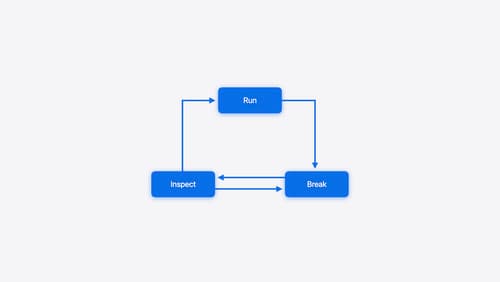call blocking
Asked on 2024-07-28
1 search
It seems like you're interested in call blocking, but the provided context doesn't directly address this topic. However, I can provide information on debugging techniques and breakpoints, which might be useful if you're dealing with issues related to call blocking in your code.
Relevant Sessions and Techniques
-
Run, Break, Inspect: Explore effective debugging in LLDB
- This session covers various techniques for handling high-firing breakpoints, which can be useful if you need to debug specific calls without stopping at every instance. Techniques include setting conditions on breakpoints and using the
tbreakcommand to create temporary breakpoints.
- This session covers various techniques for handling high-firing breakpoints, which can be useful if you need to debug specific calls without stopping at every instance. Techniques include setting conditions on breakpoints and using the
-
- This session provides an overview of setting and managing breakpoints in Xcode, including how to add conditions to breakpoints to filter out noise and focus on specific cases.
-
- This session introduces the thread performance checker, which can help identify and prioritize issues that impact your users, such as loading assets on the main thread.
Specific Techniques
-
Conditional Breakpoints: You can set a condition on a breakpoint to make it trigger only when certain criteria are met. This is useful for debugging specific calls without stopping at every instance.
- Example: In LLDB, use the
break modifycommand with a condition. - In Xcode, secondary click on the breakpoint, navigate to "Edit Breakpoint," and populate the condition field.
- Example: In LLDB, use the
-
Temporary Breakpoints: Use the
tbreakcommand to create a breakpoint that triggers only once.- Example: Set an auto-continue breakpoint on a function and create a temporary breakpoint on another function.
-
Ignoring Breakpoints: You can set a breakpoint to ignore a certain number of hits before stopping.
- Example: Modify the breakpoint to use the ignore count flag.
For more detailed information, you can refer to the specific sessions mentioned above. If you have any other questions or need further assistance, feel free to ask!

What’s new in Xcode 16
Discover the latest productivity and performance improvements in Xcode 16. Learn about enhancements to code completion, diagnostics, and Xcode Previews. Find out more about updates in builds and explore improvements in debugging and Instruments.

Run, Break, Inspect: Explore effective debugging in LLDB
Learn how to use LLDB to explore and debug codebases. We’ll show you how to make the most of crashlogs and backtraces, and how to supercharge breakpoints with actions and complex stop conditions. We’ll also explore how the “p” command and the latest features in Swift 6 can enhance your debugging experience.

Enhance your UI animations and transitions
Explore how to adopt the zoom transition in navigation and presentations to increase the sense of continuity in your app, and learn how to animate UIKit views with SwiftUI animations to make it easier to build animations that feel continuous.
